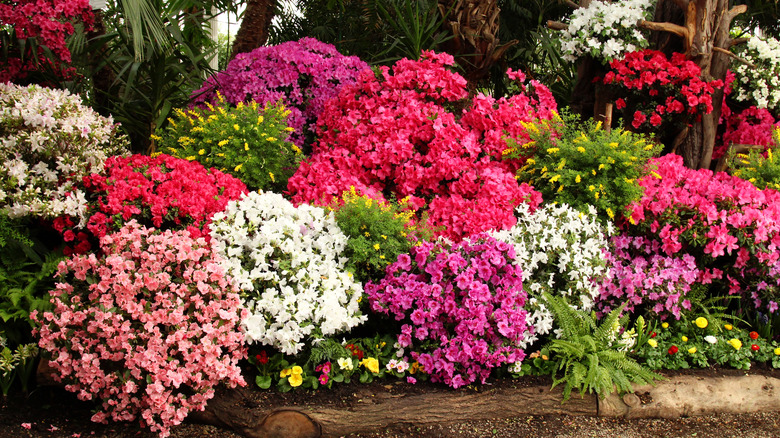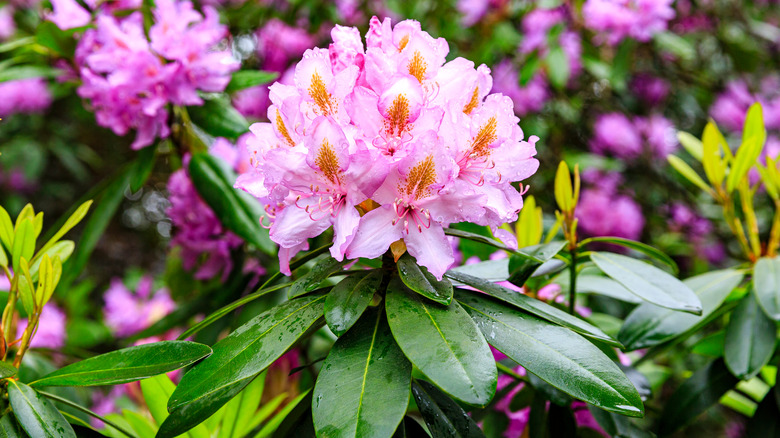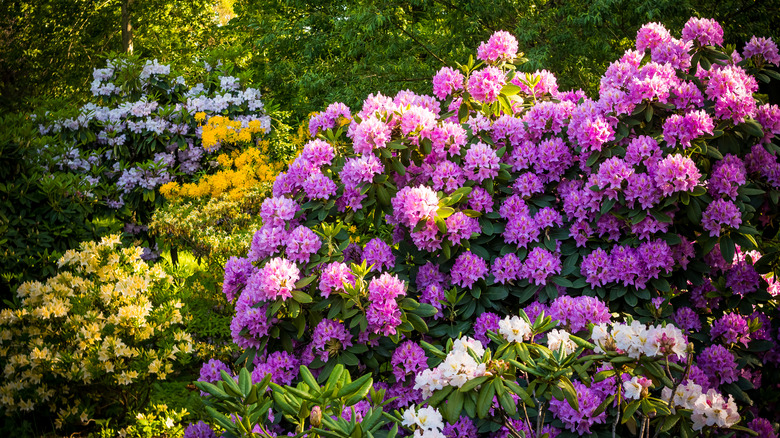Are Azaleas And Rhododendron Different Plants? Here's How To Tell Them Apart
Popular shrubs for private yards and commercial landscaping alike, azaleas come in white, pink, and purple, though they also now come in deep magenta and red-orange. Often planted in a cluster or a line, blossoming azaleas look like a big block of color. Often, azaleas are grouped alongside their cousins, plant-wise, and that's rhododendrons. Both plants are members of the Ericaceae family. This plant family includes heathers, mountain laurels, pieris, and surprisingly, cranberries and blueberries.
While all azaleas belong to the plant genus Rhododendron, rhododendrons have other cousins that are not azaleas. Are they different plants? They are, but just barely. Typically, they are planted side by side because they prefer the same growing conditions, which include acidic soil and filtered sunlight. Azaleas tend to have thinner oval leaves when compared to rhododendrons. Azaleas have multiple, funnel-shaped blooms growing along a branch, while rhododendron blossoms are bell-shaped and cluster together in a central mass, so multiple flowers look like one large blossom. Just one of these shrubs, multiple shrubs, or an entire garden offers a display of eye-catching blooms that last for weeks.
Options abound for azaleas and rhododendrons
There are many types of azalea to grow in your garden. Azalea shrubs have been hybridized and crossbred for hundreds of years, so today there are over 10,000 types of azaleas that bloom at varying times of the year (still mostly in spring, however). There is also a wide diversity in size and color. Some azaleas are deciduous, dropping their leaves at the end of the growing season, and some are evergreen. They range in size from about 3 to 6 feet high, although some varieties grow only 1 foot high and others will grow to over 15 feet.
Similarly, there are over 1,200 different species in the genus Rhododendron, and they also vary in size and shape, height, and leaf size. They come in an incredible number of colors from deep violet-blue to pink, both cotton-candy-colored to magenta, orange, and white. Imagine the ways you could "paint" your garden. The best way to care for rhododendron bushes is in climates that don't have extreme temperature changes and get plenty of rain. Consequently, they do very well in the Pacific Northwest of the U.S. and along the western coast of Great Britain and Scotland. They also grow throughout southeast Asia.
Subtle differences between the two plants
With so many different kinds of azaleas and rhododendrons, there's no hard and fast rule to tell the two shrubs apart. Most often, rhododendrons are taller than azaleas and grow to be a larger shape overall. The clustered flowers, looking like a small bouquet, usually indicate a rhododendron. Each flower has 10 stamens or more. Azaleas have a length of single flowers along their branches, and each flower has five stamens. In general, azaleas lose their leaves in fall, while rhododendron leaves remain; they just fold down toward the ground in fall and winter. Finally, azalea leaves tend to have a furry texture, while rhododendron leaves are smooth, elongated ovals.
If you have a mystery plant in your yard, you can always take a photo or a sample of a blossom or a leaf to the local garden center or nursery. State and county extension offices or a master gardener may be able to sort out what kind of shrubs are growing in your yard. No matter which plant you have, with minimum maintenance, your azalea or rhododendron will blossom every year with colorful flowers. You can also maximize the beauty of these shrubs by planting companions that complement their size, shape, and texture.


